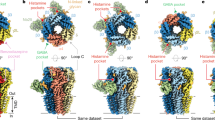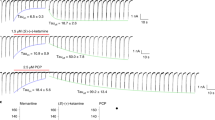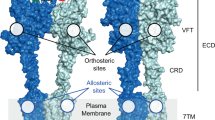Abstract
Oligomeric N-methyl D-aspartate receptor (NMDAR) in brain is a ligand-gated ion channel that becomes selectively permeable to ions upon binding to ligands. For NMDAR channel, the binding of glutamate and glycine results in opening of the calcium permeable channel. Because the calcium influx mediated by NMDAR is important for synaptic plasticity and excitotoxicity, the function of NMDA receptors has been implicated in both health and disease. Native NMDA receptors are thought to be heteromeric pentamers with a central ion conduction pathway. There are five genes (NR1, 2A, 2B, 2C, and 2D) encoding various subunits that have been cloned, and NR1 is thought to be the essential subunit since it forms a functional channel by itself. To study NMDAR structure and function, we have searched for peptide modulators of NR1 using random peptide bacteriophage libraries. The peptides were identified based on their specific association with a purified receptor fusion protein that contains the putative ligand binding domain. We report the identification of one group of cyclic peptides (Mag-1) with a consensus sequence of CDGLRHMWFC. Using biochemical binding analysis and patch clamp electro-physiological recording, we show that the synthetic Mag-1 peptides cause noncompetitive inhibition of the receptor channel activity.
This is a preview of subscription content, access via your institution
Access options
Subscribe to this journal
Receive 12 print issues and online access
$209.00 per year
only $17.42 per issue
Buy this article
- Purchase on Springer Link
- Instant access to full article PDF
Prices may be subject to local taxes which are calculated during checkout
Similar content being viewed by others
References
Choi, D.W. 1990. Possible mechanisms limiting N-methyl-D-aspartate receptor overactivation and the therapeutic efficacy of N-methyl-D-aspartate antagonists. Stroke 21: III20–22.
Bliss, T.V. and Collingridge, G.L. 1993. A synaptic model of memory: long-term potentiation in the hippocampus. Nature 361: 31–39.
Hollmann, M. and Heinemann, S. 1994. Cloned glutamate receptors. Annu. Rev. Neurosci. 17: 31–108.
Monaghan, D.T., Bridges, R.J., and Cotman, C.W. 1989. The excitatory amino acid receptors: their classes, pharmacology, and distinct properties in the function of the central nervous system. Annu. Rev. Pharmacol. Toxicol. 29: 365–402.
Nakanishi, S. 1992. Molecular diversity of glutamate receptors and implications for brain function. Science 258: 597–603.
Moriyoshi, K., et al. 1991. Molecular cloning and characterization of the rat NMDA receptor. Nature 354: 31–37.
Johnson, J.W., and Ascher, P. 1987. Glycine potentiates the NMDA response in cultured mouse brain neurons. Nature 325: 529–531.
Mayer, M.L., Westbrook, G.L., and Guthrie, P.B. 1984. Voltage-dependent block by Mg2+ of NMDA responses in spinal cord neurones. Nature 309: 261–263.
McGurk, J.F., Bennett, M.V., and Zukin, R.S. 1990. Polyamines potentiate responses of N-methyl-D-aspartate receptors expressed in xenopus oocytes. Proc. Natl. Acad. Sci. USA 87: 9971–9974.
Nowak, L., Bregestovski, P., Ascher, P., Herbet, A., and Prochiantz, A. 1984. Magnesium gates glutamate-activated channels in mouse central neurones. Nature 307: 462–465.
Peters, S., Koh, J., and Choi, D.W. 1987. Zinc selectively blocks the action of N-methyl-D-aspartate on cortical neurons. Science 236: 589–593.
Westbrook, G.L. and Mayer, M.L. 1987. Micromolar concentrations of Zn2+ antagonize NMDA and GABA responses of hippocampal neuronsNature 328: 640–643.
Wong, E.H., et al. 1986. The anticonvulsant MK-801 is a potent N-methyl-D-aspartate antagonist. Proc. Natl. Acad. Sci. USA 83: 7104–7108.
Smith, G.P. 1985. Filamentous fusion phage: novel expression vectors that display cloned antigens on the virion surface. Science 228: 1315–1317.
Scott, U.K. and Smith, G.P. 1990. Searching for peptide ligands with an epitope library. Science 249: 386–390.
Devlin, J.J., Panganiban, L.C., and Devlin, P.E. 1990. Random peptide libraries: a source of specific protein binding molecules. Science 249: 404–406.
Cwirla, S.E., Peters, E.A., Barrett, R.W., and Dower, W.J. 1990. Peptides on phage: a vast library of peptides for identifying ligands. Proc. Natl. Acad. Sci. USA 87: 6378–6382.
Whitehorn, E.A., Tate, E., Yanofsky, S.D., Kochersperger, L., Davis, A., Mortensen, R.B., et al. 1995. A generic method for expression and use of “tagged” soluble versions of cell surface receptors. Bio/Technology 13: 1215–1219.
Chazot, R.L., Cik, M., and Stephenson, F.A. 1992. Immunological detection of the NMDAR1 glutamate receptor subunit expressed in embryonic kidney 293 cells and in rat brain. J. Neurochem. 59: 1176–1178.
Barrett, R.W., et al. 1992. Selective enrichment and characterization of high affinity ligands from collections of random peptides on filamentous phage. Anal. Biochem. 204: 357–364.
Hollmann, M., O'Shea-Greenfield, A., Rogers, S.W., and Heinemann, S. 1989. Cloning by functional expression of a member of the glutamate receptor family. Nature 342: 643–648.
Hollmann, M., et al. 1993. Zinc potentiates agonist-induced currents at certain splice variants of the NMDA receptor. Neuron 10: 943–954.
Haack, J.A., et al. 1990. Conantokin-T. A gamma-carboxyglutamate containing peptide with N-methyl-D-aspartate antagonist activity. J. Biol. Chem. 265: 6025–6029.
Huettner, J.E. and Bean, B.P. 1988. Block of N-methyl-D-aspartate-activated current by the anticonvulsant MK-801: selective binding to open channels. Proc. Natl. Acad. Sci. USA 85: 1307–1311.
Mori, H., Masaki, H., Yamakura, T., and Mishina, M. 1992. Identification by mutagenesis of a Mg(2+)-block site of the NMDA receptor channel. Nature 358: 673–675.
Monyer, H., et al. 1992. Heteromeric NMDA receptors: molecular and functional distinction of subtypes. Science 256: 1217–1221.
Tingley, W.G., Roche, K.W., Thompson, A.K., and Huganir, R.L. 1993. Regulation of NMDA receptor phosphorylation by alternative splicing of the C-terminal domain. Nature 364: 70–73.
Kutsuwada, T., et al. 1992. Molecular diversity of the NMDA receptor channel. Nature 358: 36–41.
Lucas, D.R. and Newhouse, J. 1957. The toxic effect of sodium L-glutamate on the inner layers of retina. Arch. Ophthalmol. 58: 193–204.
Choi, D.W. and Rothman, S.M. 1990. The role of glutamate neurotoxicity in hypoxic-ischemic neuronal death. Annu. Rev. Neurosci. 13: 171–182.
Miller, R.J., Murphy, S.N., and Glaum, S.R. 1989. Neuronal Ca2+ channels and their regulation by excitatory amino acids. Ann. NY Acad. Sci. 568: 149–158.
Young, A.B., Penney, J.B., Dauth, G.W., Bromberg, M.B., and Gilman, S. 1983. Glutamate or aspartate as a possible neuretransmitter of cerebral corticofugal fibers in the monkey. Neurology 33: 1513–1516.
Rothstein, J.D., et al. 1991. Excitatory amino acids in amyotrophic lateral sclerosis: an update. Ann. Neurol. 30: 224–225.
Rothstein, J.D., Martin, L.J., and Kuncl, R.W. 1992. Decreased glutamate transport by the brain and spinal cord in amyotrophic lateral sclerosis. N. Engl. J. Med. 326: 1464–1468.
Rothstein, J.D., Jin, L., Dykes-Hoberg, M., and Kuncl, R.W. 1993. Chronic inhibition of glutamate uptake produces a model of slow neurotoxicity. Proc. Natl. Acad. Sci. USA 90: 6591–6595.
Rothstein, J.D., et al. 1994. Localization of neuronal and glial glutamate transporters. Neuron 13: 713–725.
Storm-Mathisen, J. and Ottersen, O.P. 1987. Tracing of neurons with glutamate or gamma-aminobutyrate as putative transmitters. Biochem. Soc. Trans. 15: 210–213.
Storm-Mathisen, J. and Ottersen, O.P. 1990. Immunocytochemistry of glutamate at the synaptic level. J. Histochem. Cytochem. 38: 1733–1743.
O'Brien, R.J. and Fischbach, G.D. 1986. Modulation of embryonic chick motoneuron glutamate sensitivity by intemeurons and agonists. J. Neurosci. 6: 3290–3296.
Tsai, G.C., et al. 1991. Reductions in acidic amino acids and N-acetylaspartylglu-tamate in amyotrophic lateral sclerosis CNS. Brain Res. 556: 151–156.
Shaw, P.J. 1994. Excitotoxicity and motor neurone disease: a review of the evidence. J. Neurol. Sci. 124: 6–13.
Shaw, P.J. 1994. Excitotoxicity and motor neurone disease: a review of the evidence. J. Neurol. Sci. 124: 6–13.
Lipton, S.A. and Stamler, J.S. 1994. Actions of redox-related congeners of nitric oxide at the NMDA receptor. Neuropharmacology 33: 1229–12233.
Li, M., Jan, Y.N., and Jan, L.Y. 1992. Specification of subunit assembly by the hydrophilic amino-terminal domain of the Shaker potassium channel. Science 257: 1225–1230.
Guzman, L.M., Belin, D., Carson, M.J., and Beckwith, J. 1995. Tight regulation, modulation, and high-level expression by vectors containing the arabinose PBAD promoter. J. Bacteriol. 177: 4121–4130.
Author information
Authors and Affiliations
Rights and permissions
About this article
Cite this article
Li, M., Yu, W., Chen, CH. et al. In vitro selection of peptides acting at a new site of NMDA glutamate receptors. Nat Biotechnol 14, 986–991 (1996). https://doi.org/10.1038/nbt0896-986
Received:
Accepted:
Issue Date:
DOI: https://doi.org/10.1038/nbt0896-986
This article is cited by
-
Role of glutamatergic and GABAergic systems in alcoholism
Journal of Biomedical Science (2001)
-
Use of a modified bacteriophage to probe the interactions between peptides and ion channel receptors in mammalian cells
Nature Biotechnology (1997)
-
NO NMDA receptor activity
Nature Biotechnology (1996)



